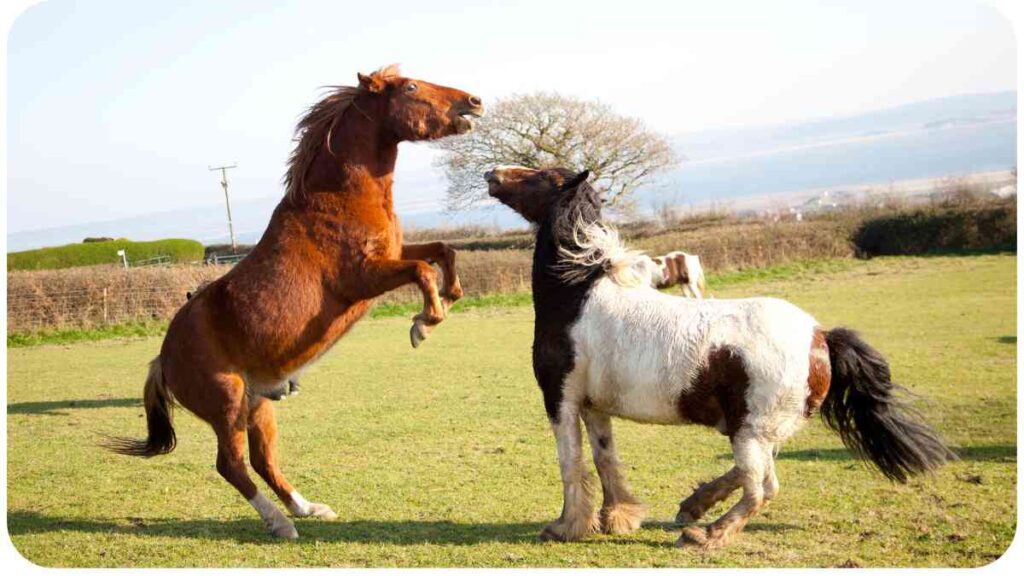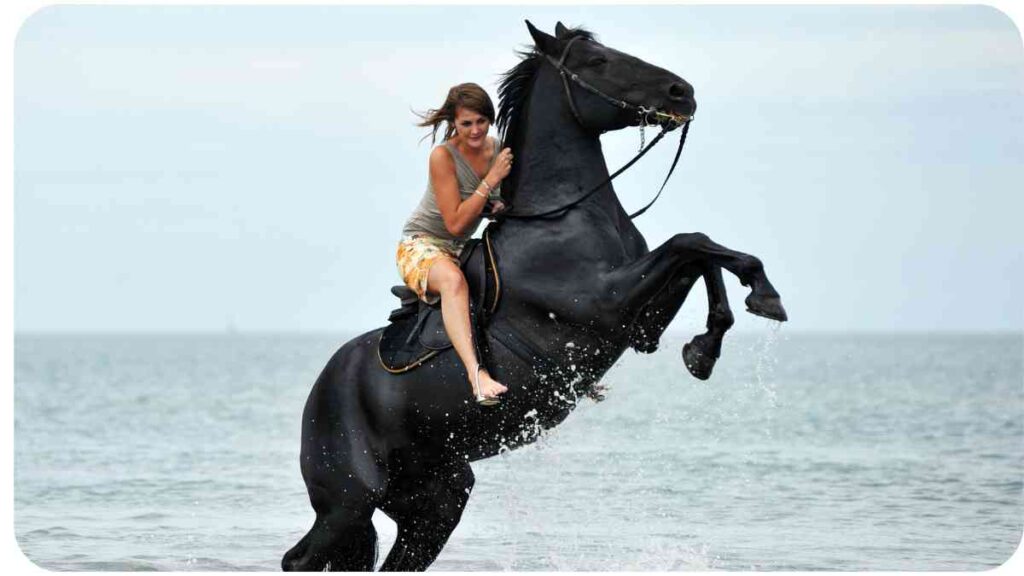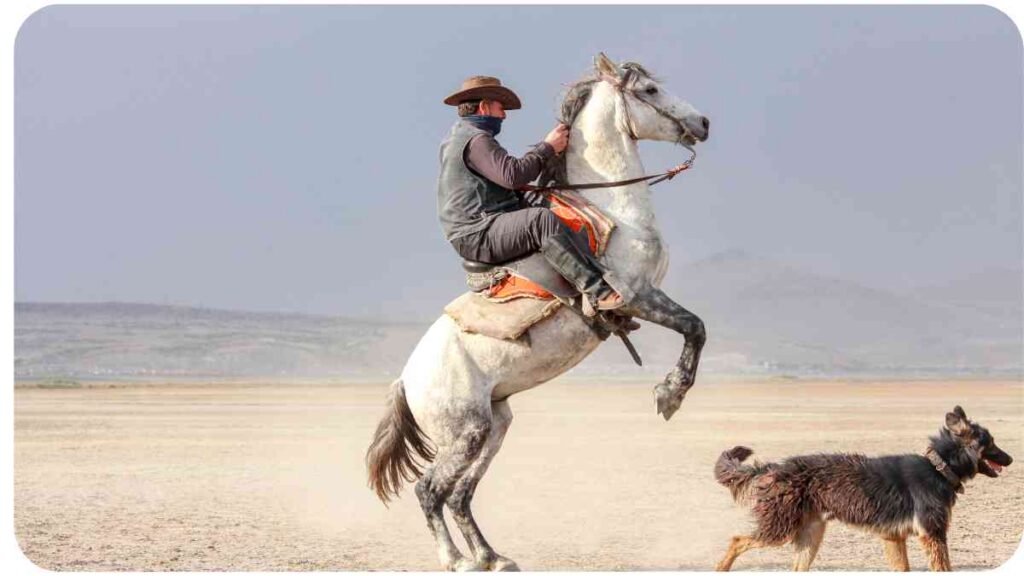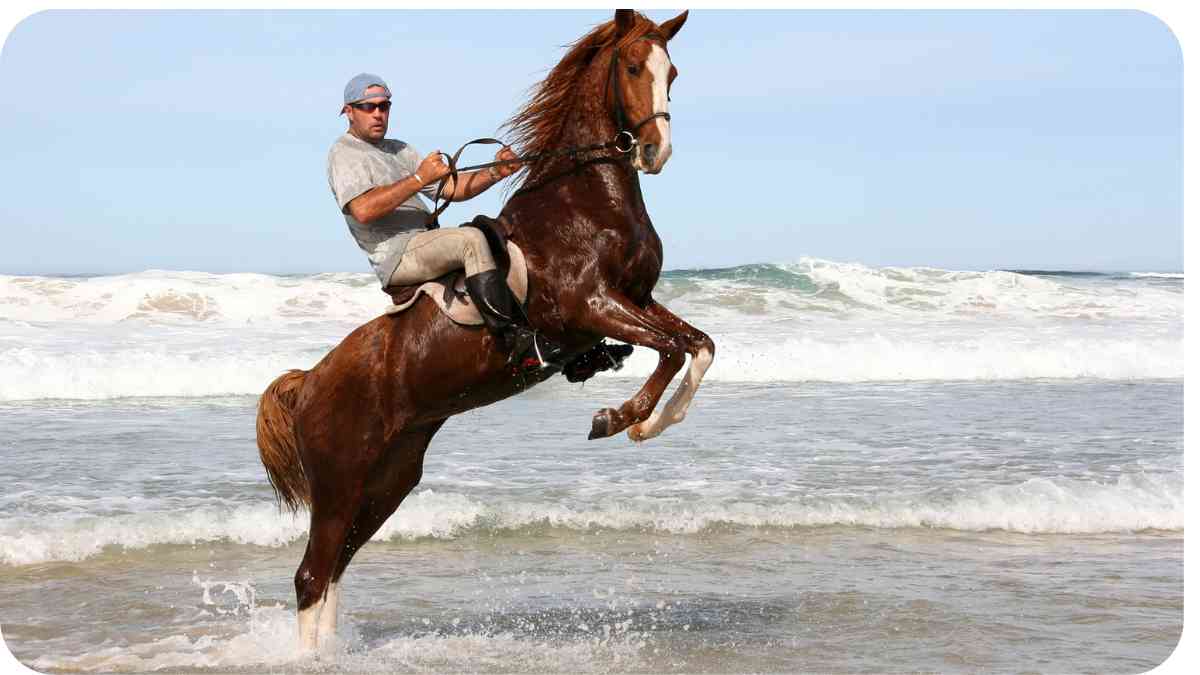Horse rearing is a behavior that can be unsettling and dangerous for both horse and rider. Understanding the root causes of this behavior is crucial for effective management and training. In this article, we will delve into equine behavior, explore the reasons why horses rear, and provide practical tips for handling and preventing unwanted behaviors.
By developing a deeper understanding of your horse’s behavior, you can create a strong foundation of trust and partnership, leading to a safer and more enjoyable equestrian experience.
| Takeaways |
| Understand the reasons behind horse rearing |
| Prioritize safety when dealing with rearing |
| Identify warning signs to intervene early |
| Address the root cause of rearing behaviors |
| Seek professional help if necessary |
| Prevention is essential for managing rearing |
| Consistent routines and groundwork are crucial |
| Regular exercise and mental stimulation are key |
| Proper tack and equipment contribute to safety |
| Regular evaluation of health and nutrition |
Understanding Equine Behavior
To effectively address rearing behaviors in horses, it is essential to comprehend the various factors that influence their behavior. Horses are highly intuitive animals, sensitive to their surroundings and the emotions of their handlers. Let’s explore some key aspects of equine behavior and how they relate to rearing.
Understanding and Preventing Equine Colic is essential for every horse owner. Colic can be a life-threatening condition, and this guide provides important tips to help you recognize and prevent it in your horses.
Instinctual Behaviors
Horses have inherent instincts that have been shaped by thousands of years of evolution. These behavioral patterns, such as flight or fight responses, play a significant role in understanding their actions. By acknowledging and respecting these instincts, we can better interpret and influence our horse’s behavior.
Environmental Factors

The environment in which a horse lives plays a crucial role in their overall well-being and behavior. A serene and adequately managed environment can create a sense of security, while a chaotic or stressful environment can trigger anxiety and unwanted behaviors, including rearing. Providing a calm and predictable atmosphere is paramount in fostering a well-behaved and contented horse.
Sometimes, horse blankets can cause discomfort. Learn how to address these issues with quick troubleshooting tips to ensure your horse stays comfortable and healthy during cold weather.
Emotional Triggers
Emotions also strongly influence equine behavior. Horses have the ability to perceive and react to human emotions. Stress, fear, and uncertainty can be communicated to the horse through subtle body language cues. It’s important to be aware of our own emotional state when interacting with our horses, as it can significantly impact their response.
Health Issues
Physical discomfort or pain can lead to behavioral issues in horses. Conditions such as ill-fitting tack, dental problems, musculoskeletal issues, or internal discomfort can cause a horse to rear as a way to express their discomfort. Regular veterinary care and addressing any underlying health issues are vital for maintaining a horse’s well-being and preventing unwanted behaviors.
Communicating Through Body Language

Horses primarily communicate through body language. They use subtle movements, postures, and expressions to convey their feelings and intentions. As horse owners, it is essential to develop our understanding of equine body language. This knowledge allows us to better identify early warning signs, communicate effectively with our horses, and address any potential rearing concerns.
Selecting the right horse feed is crucial. The guide on decoding horse feed labels provides valuable insights to make informed decisions about your horse’s nutrition.
The Role of Trust and Bonding
Developing a bond of trust and mutual respect is an integral part of a positive and successful horse-human relationship. Horses are social animals that naturally seek connection and companionship. Building trust through positive interactions, consistent handling, and clear communication lays the foundation for resolving challenging behavior, including rearing.
Let’s now take a closer look at some of the most common reasons why horses rear, along with relevant data in a table format.
| Reasons for Horse Rearing | Description |
| Fear and Anxiety | Horses may rear when they feel threatened or overwhelmed by certain situations or stimuli. |
| Pain and Discomfort | Physical discomfort, such as ill-fitting tack or underlying health issues, can trigger rearing. |
| Lack of Training or Discipline | Insufficient training and inconsistent boundaries can lead to disrespectful or rebellious behavior, including rearing. |
| Poor Ground Manners | A lack of respect for personal space, leading |
Understanding these reasons for horse rearing will help us address the behavior effectively and establish a safer and more harmonious partnership with our equine companions.
Handling Rearing Behaviors
When faced with a horse rearing, it’s vital to prioritize safety for both the horse and the rider. Taking appropriate precautions and following a systematic approach can help manage and address the behavior. Here are some key steps to handling rearing behaviors:
Experiencing your horse buck can be a challenging situation. Discover the causes and solutions behind this behavior to ensure the safety and well-being of both you and your horse.
Safety First: Putting on Protective Gear
Before addressing the rearing behavior, it’s essential to ensure the safety of both the rider and the horse. Putting on the necessary protective gear, such as a properly fitted helmet and appropriate riding attire, minimizes the risk of injury in case of a fall or sudden movements by the horse.
Identifying Warning Signs
Recognizing the early warning signs of rearing can help intervene before the behavior escalates. Signs may include tensing of the body, raised head, pinned ears, and shifts in body weight. By staying attentive and vigilant, we can respond appropriately and promptly to prevent the horse from going into a full rear.
Establishing a Safe Environment
Creating a safe training environment plays a crucial role in managing rearing behaviors. Remove any potential hazards or distractions from the area where you work with your horse. Ensure that the training space is properly enclosed and free from any objects that could startle or provoke the horse.
Before hitting the trails, understanding horse riding etiquette is essential. This guide will help you maintain a safe and enjoyable environment for all riders on the trail.
Addressing the Root Cause
Identifying and addressing the underlying cause of rearing is fundamental to resolving the behavior. Depending on the reason, different approaches may be necessary. For instance, if the rearing stems from pain or discomfort, seeking veterinary care and ensuring the horse’s well-being should be the priority. If the behavior is due to fear or anxiety, implementing desensitization and counterconditioning techniques can be beneficial.
Seek Professional Help if Necessary
Dealing with rearing behaviors can be challenging, especially if the horse’s safety or your own is at risk. If you are unsure how to handle the situation or if the behavior persists despite your efforts, it’s crucial to seek help from a professional trainer or equine behaviorist. They can provide expert guidance tailored to your specific situation.
| Training Technique | Benefit |
| Positive Reinforcement | Encourages desired behaviors through rewards, reinforcing the horse’s understanding and building a positive association with training. |
| Desensitization | Gradually exposing the horse to the source of fear or anxiety, helping them become desensitized and less likely to react with rearing. |
| Counterconditioning | Pairing a negative stimulus with a positive experience, creating a new positive association and reducing the likelihood of rearing. |
| Building Confidence | Fostering the horse’s self-assurance through gradual challenges and successes, reducing anxiety and building trust in their abilities. |
| Consistent Training | Providing clear and consistent cues and expectations during training sessions, promoting trust and understanding between horse and rider. |
Implementing a combination of these techniques, tailored to the horse’s specific needs, can help modify rearing behaviors and create a more positive and cooperative partnership.
Preventing Horse Rearing

Prevention is always better than cure when it comes to horse rearing behaviors. By establishing good groundwork, maintaining a consistent routine, and addressing any potential triggers, we can minimize the likelihood of rearing incidents. Here are some effective strategies for preventing rearing:
Proper Handling and Groundwork
Groundwork is an essential foundation for establishing respect, trust, and clear communication with your horse. Focus on teaching your horse ground manners, such as respecting your personal space, yielding to pressure, and following basic commands. Engaging in regular groundwork exercises builds a solid relationship and strengthens the horse’s trust in you as the leader.
Regular Exercise and Mental Stimulation
Providing regular exercise and mental stimulation is vital for a well-rounded horse. Physical and mental enrichment through varied activities, such as trail rides, schooling exercises, or engaging in natural horsemanship techniques, helps keep the horse content and less inclined to exhibit unwanted behaviors like rearing.
Balanced Diet and Health Maintenance
A healthy and balanced diet is essential for the overall well-being of a horse. Ensure that your horse receives the appropriate nutrition with high-quality forage, balanced concentrates, and access to clean water. Regular veterinary checks, vaccinations, dental care, and farrier visits are crucial for maintaining the horse’s health. Addressing any health issues promptly can prevent discomfort and contribute to better behavior.
Maintaining a Consistent Routine
Horses thrive on routine and predictability. Establishing a consistent schedule for feeding, exercise, grooming, and training helps create a sense of security for the horse. Consistency allows the horse to understand what is expected of them and reduces the likelihood of stress-induced behaviors such as rearing.
Let’s provide a table illustrating the importance of consistent routines in horse care and training.
| Benefits of Consistent Routines |
| Establishes a sense of security and predictability for the horse |
| Builds trust and confidence in the horse |
| Helps the horse understand expectations and boundaries |
| Reduces stress and anxiety by minimizing uncertainties |
| Encourages better behavior and cooperation |
Regular Evaluation of Tack and Equipment
Properly fitting tack and equipment are essential for a comfortable and secure riding experience. Regularly assess the fit and condition of the saddle, bridle, girth, and any other equipment used. Ill-fitting or uncomfortable tack can cause discomfort, leading to undesirable behaviors such as rearing. Be sure to consult with a knowledgeable professional to ensure proper fitting.
By implementing these preventive measures and staying attentive to your horse’s needs, you can create a positive environment that fosters good behavior and minimizes the risk of rearing.
Conclusion
Understanding why horses rear and how to handle this unwanted behavior is vital for the safety and well-being of both horse and rider. By delving into equine behavior, recognizing the common triggers for rearing, and employing appropriate training techniques, we can foster a harmonious partnership with our horses.
Through consistent training, preventative measures, and attentive care, we can minimize the occurrence of rearing and create a positive and enjoyable equestrian experience. Remember, every horse is unique, so it’s essential to build a bond of trust and tailor your approach to their individual needs. Stay committed, seek professional guidance when needed, and never underestimate the power of patience, compassion, and understanding in working with horses. Happy riding!
Further Reading
Here are some additional resources for further reading on the topic of horse rearing and behavior:
- Unwanted Behaviors and Vices in Horses: This article from the University of Minnesota Extension provides a comprehensive overview of various unwanted behaviors in horses, including rearing, and offers insights into their causes and management strategies.
- Observation: Rearing or Pulling Back When Led in Hand: The Horse Side Vet Guide discusses the observations, causes, and potential solutions for rearing or pulling back when leading a horse. This practical resource offers concise and valuable information for horse owners and handlers.
- Behavior Problems in Horses: The Merck Veterinary Manual provides an in-depth overview of behavior problems in horses, highlighting the possible reasons behind rearing and other undesirable behaviors. The article offers insights into the diagnosis, prevention, and management of behavior issues in horses.
FAQs
How can I prevent my horse from rearing?
Preventing horse rearing often involves addressing the underlying causes, such as fear, pain, or inadequate training. Developing a strong bond with your horse, providing consistent training, regular exercise, and ensuring a safe environment can help prevent rearing behaviors.
What should I do if my horse starts to rear?
When a horse starts to rear, it’s crucial to prioritize safety. Stay calm, maintain a firm grip on the reins, and try to bring the horse’s head down. Avoid pulling back forcefully, as it can exacerbate the behavior. Seek professional help if you are unsure how to handle the situation.
Can rearing be a sign of pain or discomfort?
Yes, rearing can be a sign of pain or discomfort in horses. It is important to assess the horse’s overall health, including its diet, hoof condition, dental health, and saddle fit, to identify and address any potential sources of pain.
Is rearing a normal behavior for horses?
Rearing is not a normal behavior for horses in a well-managed and trained setting. While some young horses may display occasional playful rearing, persistent or aggressive rearing can indicate underlying issues and should be addressed.
Can training techniques help mitigate rearing behaviors?
Yes, training techniques such as positive reinforcement, desensitization, consistent boundaries, and building trust can help mitigate rearing behaviors. Working with a professional trainer can provide valuable guidance in implementing effective training methods.

Hi there! My name is Hellen James, and I’m a horse riding expert. I’ve been riding horses since I was just a kid—and it’s been my passion ever since. But getting started with horse riding can be overwhelming. There’s so much to learn! If you’re looking for a way to get started and make sure you’re doing it right, I’m here to help.


